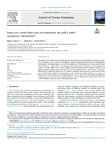Long-Term Versus Short-Term Environmental Tax Policy Under Asymmetric Information

Use this link to cite
http://hdl.handle.net/2183/38752
Except where otherwise noted, this item's license is described as Atribución 4.0 Internacional (CC BY)
Collections
- Investigación (FEE) [923]
Metadata
Show full item recordTitle
Long-Term Versus Short-Term Environmental Tax Policy Under Asymmetric InformationDate
2023Citation
Antelo, M., Bru, L., & Peón, D. (2023). Long-term versus short-term environmental tax policy under asymmetric information. Journal of Cleaner Production, 427, 139078. 10.1016/j.jclepro.2023.139078
Abstract
[Abstract] We examine the interaction between a firm that uses either a dirty or a clean technology to produce a product over two periods, 1 and 2, and an environmentally conscious regulator that chooses the environmental tax/subsidy policy. The regulator ignores with which technology the firm manufactures the product and only has a prior belief about it. In this context, if the regulator can credibly commit to the policy for both periods, social welfare is generally higher than if it cannot commit, because distortions in firm's production at period 1 for signalling purposes strongly reduces the optimality of an environmental policy of short duration. A period-by-period policy in which the regulator does not commit to the policy terms for period 2 (which will be contingent to information provided by the firm in period 1) is only optimal when clean technology is very expensive to produce with it and the regulator's environmental concern is not very high. The results highlight the importance of taking into account the time horizon in policymaking, as well as the limitations of regulatory policies that seek to elicit information about the type of technology used by firms.
Keywords
Clean and dirty technology
Short-term and long-term environmental tax/subsidy policy
Asymmetric information
Welfare
Short-term and long-term environmental tax/subsidy policy
Asymmetric information
Welfare
Editor version
Rights
Atribución 4.0 Internacional (CC BY)
ISSN
0959-6526






